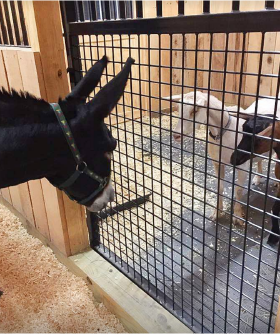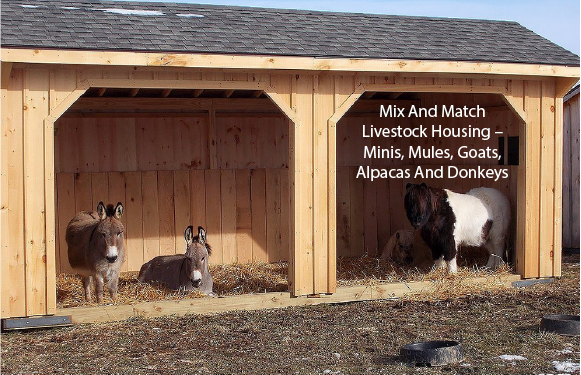Mix And Match Livestock Housing – Minis, Mules, Goats, Alpacas And Donkeys
by Nikki Alvin-Smith
Animals come in many shapes and sizes and keeping a myriad of species of four-legged critters on your property poses stabling, stall and barn needs for their care. Aside from providing shelter to the animals from the sun’s hot rays and blasts of wintry weather a barn offers an opportunity to increase space for storage on the property for everything from A to Z – ATVs to mowers, tools to tractors as well as food and bedding supplies necessary to care for the wee beasties.
Mix and match livestock keeping may include minis, mules, goats, alpacas, and donkeys. There are plenty of pleasurable times to be enjoyed owning these animals and observing these animals at play, but for some property owners their use may be part of a commercial enterprise farming wool, meat/milk products, breeding animals for sale or offer a petting farm for children to visit and learn about animals.
Smaller critters may not be as intimidating to own as larger ones like cows or horses, and while they may not need as much space to house or as much pasture to graze, their presence on the property will produce similar concerns when it comes to safety, security, and issues such as manure management and medical care.
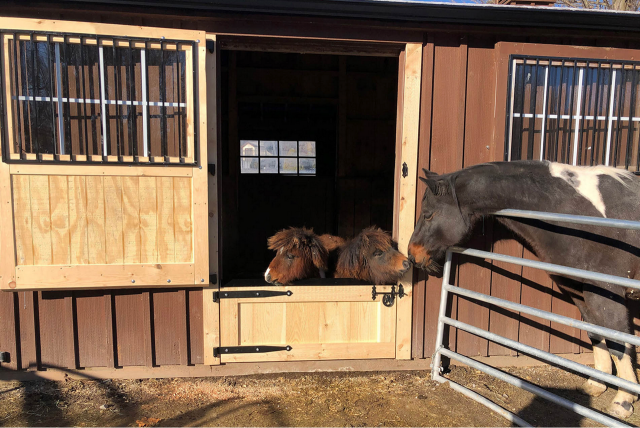
What sort of barn should you buy and what are the pros and cons of each type? Here are some helpful ideas to inspire your best decision.
Run-In Sheds Can Work
The use of multiple run-in sheds for shelter can work as a shelter option especially if their placement is not facing prevailing wind direction and extra structures are added where food supplies such as hay can be stored separately from the animals.
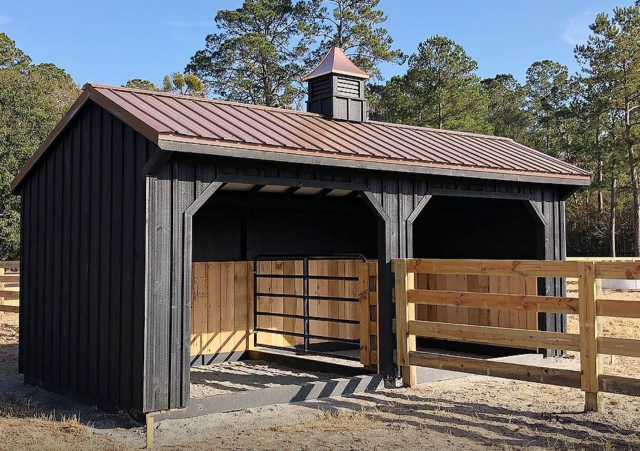
Goats are notoriously good at destroying a carefully stacked hay supply jumping back and forth and eventually wasting much of the expensive product as bedding rather than a food supply.
Freedom of movement in and out of the structure as they choose can be good for the herd although there is always the chance that those critters lower in the pecking order will be bullied and left standing outside in adverse weather.
The problem with freedom of movement is that other animals can also come and go in the structure. This may include predators such as coyote, over playful neighborhood dogs or disease transmitters such as possums or raccoons.
Donkeys and Llamas are especially good deterrents to such invasions and will protect the rest of the animal ensemble also sometimes sounding the alarm of nefarious activity occurring by braying or in the case of Llamas emitting a very loud high-pitched sound if a predator is espied and it feels threatened.
Other downsides of run-in sheds include the possible access difficulty and expense of providing light and water to multiple locations; being able to fully secure the animals during your temporary absence from the property or during extreme weather such as hurricanes or winter storms; the requirement to tromp back and forth between locations with feed and bedding supplies, tools and equipment for clean out and the added time and energy it takes to complete animal care tasks.
Shed Row Style
A shed row style barn offers excellent flexibility in use and automatically provides a courtyard if two shedrow structures are placed at a right angle to each other. A courtyard offers protection from high wind and privacy from nearby road traffic or neighbors.
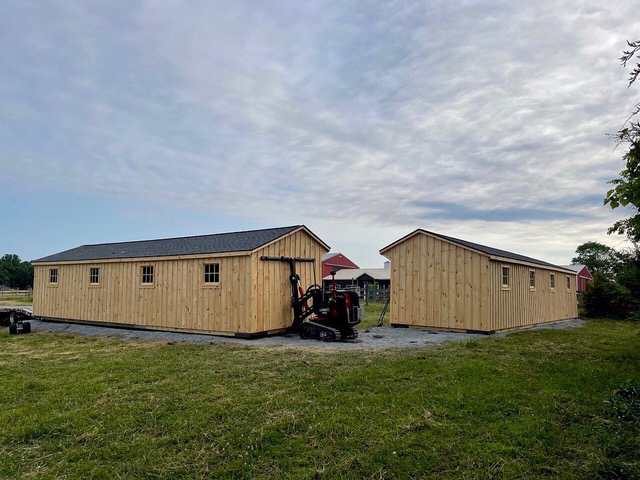
Some spaces can be finished as stalls or storage areas while other areas can be left open for freedom of access for the critters.
Multi-Purpose Barn Designs
A multi-use building is a great way to manage the care of the mixed herd all in one place. This style of barn can save both time and money. Efficiency taking care of daily tasks such as feeding and mucking out the animals is easy to accomplish as the supplies and equipment are centralized, money is saved adding services to the structure such as electricity and water as only one location needs to be accessed.
Everything under one roof concept has always been a mainstay style of barn in farm life. In days gone by progression of barn design was determined by the availability of materials required for the build and also by the farmers’ needs. Hence the creation of the Monitor Barn the forerunner of the American center aisle barn.
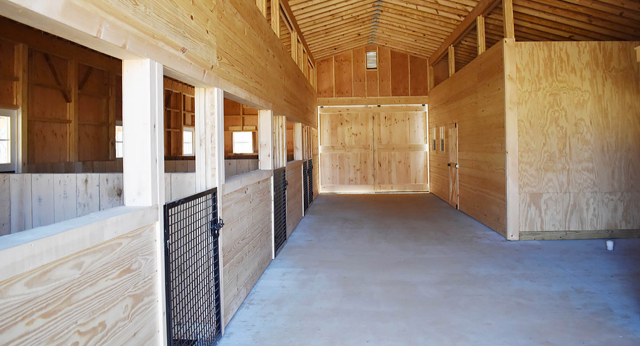
Modification of a horse barn design for use for smaller Equus and other livestock is a common practice. Modular horse barn builders such as the Lancaster County, PA based company Horizon Structures, offer Amish crafted structures that can be customized to accommodate a bevy of animal types.
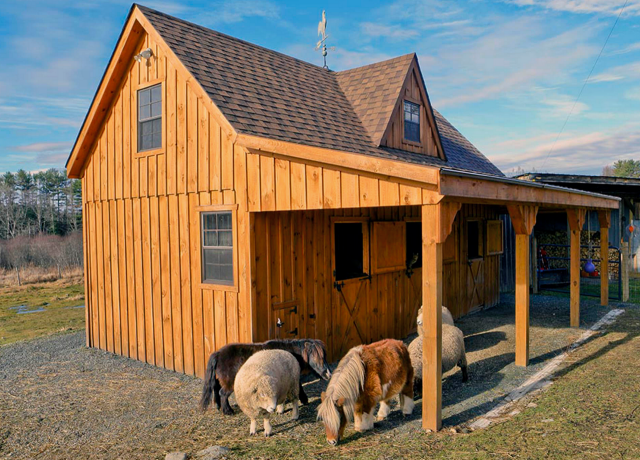
The installation of Dutch doors that are low enough in height for the miniature horse or donkey to see over, window placement at lower aspects, and reduced interior stall dimensions from regular sized horse stabling needs can all service wee critters neatly. The added advantage is not only that these customizations give the animals a room with a view, but it also facilitates access over the stable door for visitors to pet and engage with the animals.
Of course, when it comes to goats keeping them all in one place can be a challenge. A low door will provide a good jumping off point for escape. Access from predators to the barn especially at nighttime is also a concern especially for young animals.
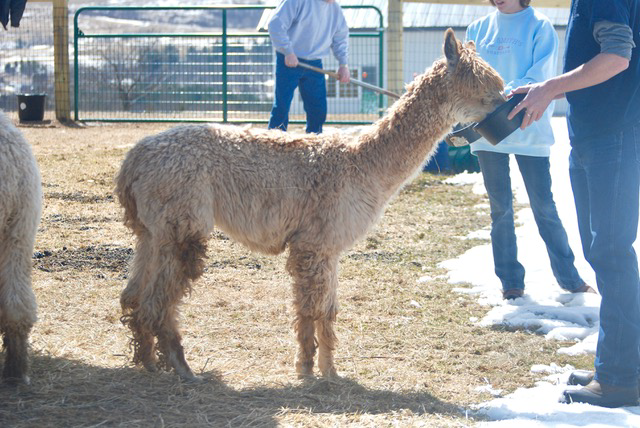
Herds of goats or alpacas prefer to share accommodation for both comfort and warmth. The multi-use barn can easily be designed to have multiple means of ingress and egress, so that each area within the barn can be divided with gates that offer versatility in space sectioning, or permanent walls and doors may be installed. These areas within the building can be serviced with their own entranceway to a specific paddock or grazing area.
If breeding goats or alpacas is an expected activity then it is also a great idea to include a kitchen, birthing or vet room that offers warmth and peace and quiet as a birthing space for the animals, hot water for veterinary needs, and a spot where orphan animals or sick animals can be cared for and kept apart from the rest of the herd.
Crias, lambs and kids, are all vulnerable to extremes of hot or cold weather so provision of shelter is a must especially for sick or distressed animals. A vet room also offers an area where medical supplies such as medications to deworm for diseases such as Meningeal worm (Parelaphostrongylus tenuis) for alpacas, vaccines for Clostridial diseases such as CD-T toxoid to protect against enterotoxaemia caused by Clostridium perfringens types C and D and also tetanus caused by Clostridium tetani.
Mud and Mayhem and Manure
Wherever high traffic areas exist in regions with a decent rainfall, areas of mud and mayhem will follow. It makes sense to add drainage around any structure to remove water from the exterior walls of the structure, gutters to buildings that exit water away from the building and add compacted gravel/stonedust or other commercial aggregate or products to entrances to both barns and gates to pastures or even across turn-out areas of heavy use and abuse.
Figure in some form of motorized equipment to help move manure a good distance away from the barn to a compost heap or to a closed container manure removal system (some townships require its removal from the property). This good hygiene health practice will mitigate odors from manure and minimize health risks associated with pesky flying insects including disease carrying mosquitoes and flies. A small plastic trailer attached to a lawn tractor or ATV/UTV, or a compact tractor can be a boon to the smallholder saving much labor pushing wheelbarrows around the property.
Plan Ahead
The purchase of a larger multi-use barn over a few run-in sheds may initially scare the livestock owner off even looking at this design as an option for animal shelter due to the perception of higher costs.
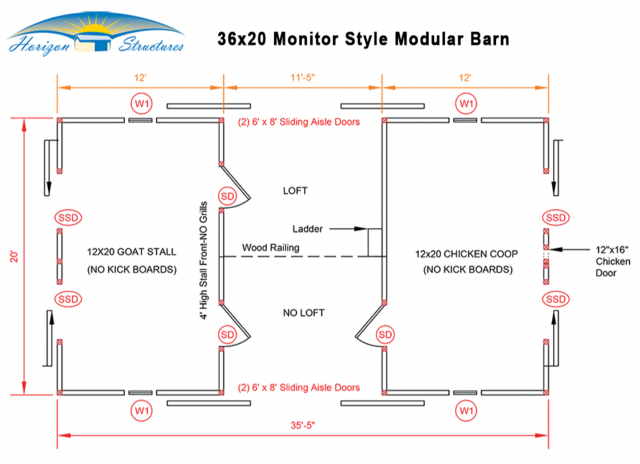
The size of the larger footprint may be easily managed with good design and the costs for customization can also be budgeted with the help of a knowledgeable construction company with a customer service forward ethic and team trained and experienced in barn needs for mixed herds.
Capital expenses for the purchase may be financed through larger construction firms that offer it through carefully researched 3rd party offerings, and delivery and set up with ‘to the penny’ quotes are available for modular designs of both large and small barns, from run-in sheds to large barns with overhangs and special feature builds such as hybrid timber frame construction.
Don’t be shy to ask for advice and ideas on how best to manage you mixed livestock needs for shelter from these experienced personnel. None of us know what we don’t know!
